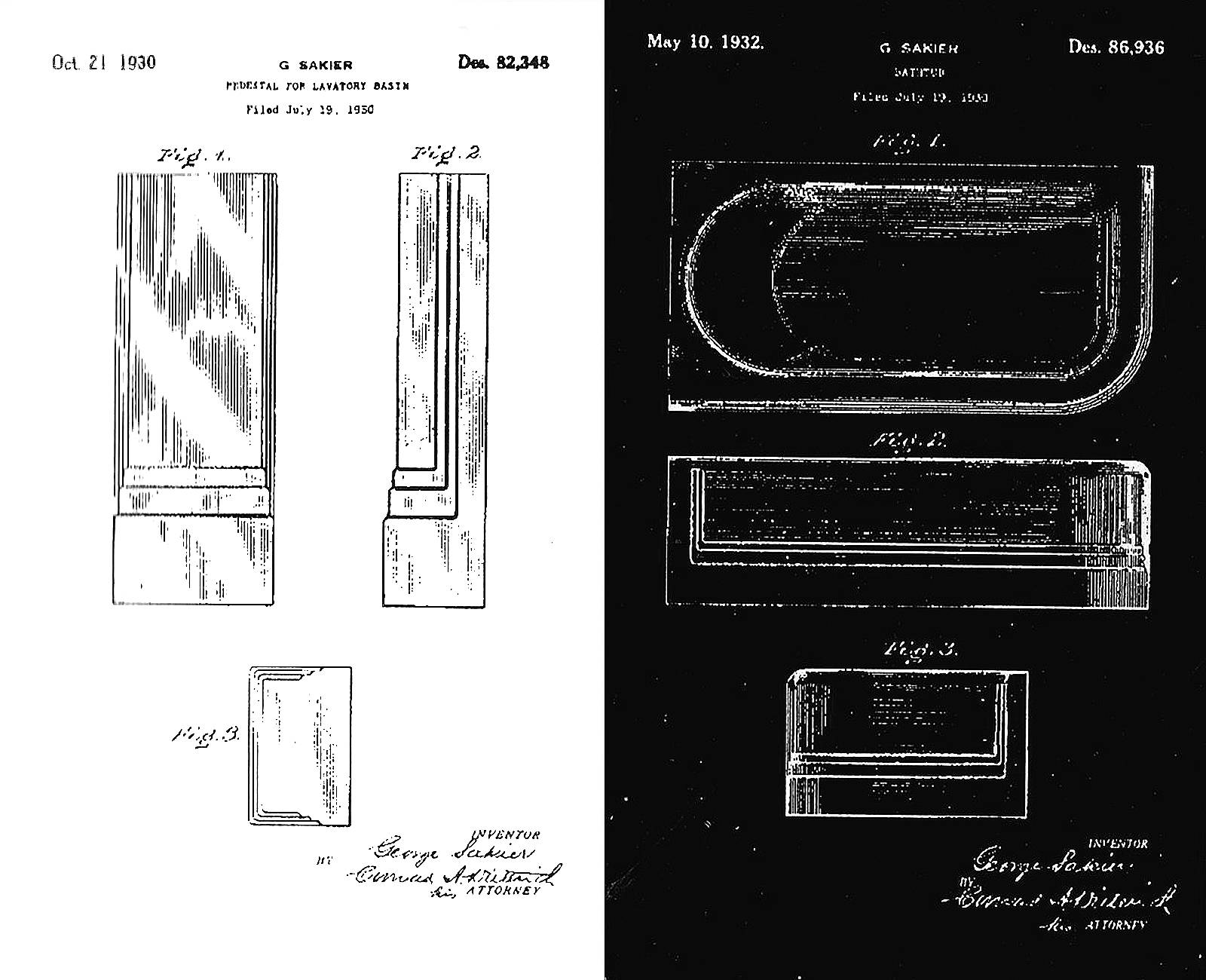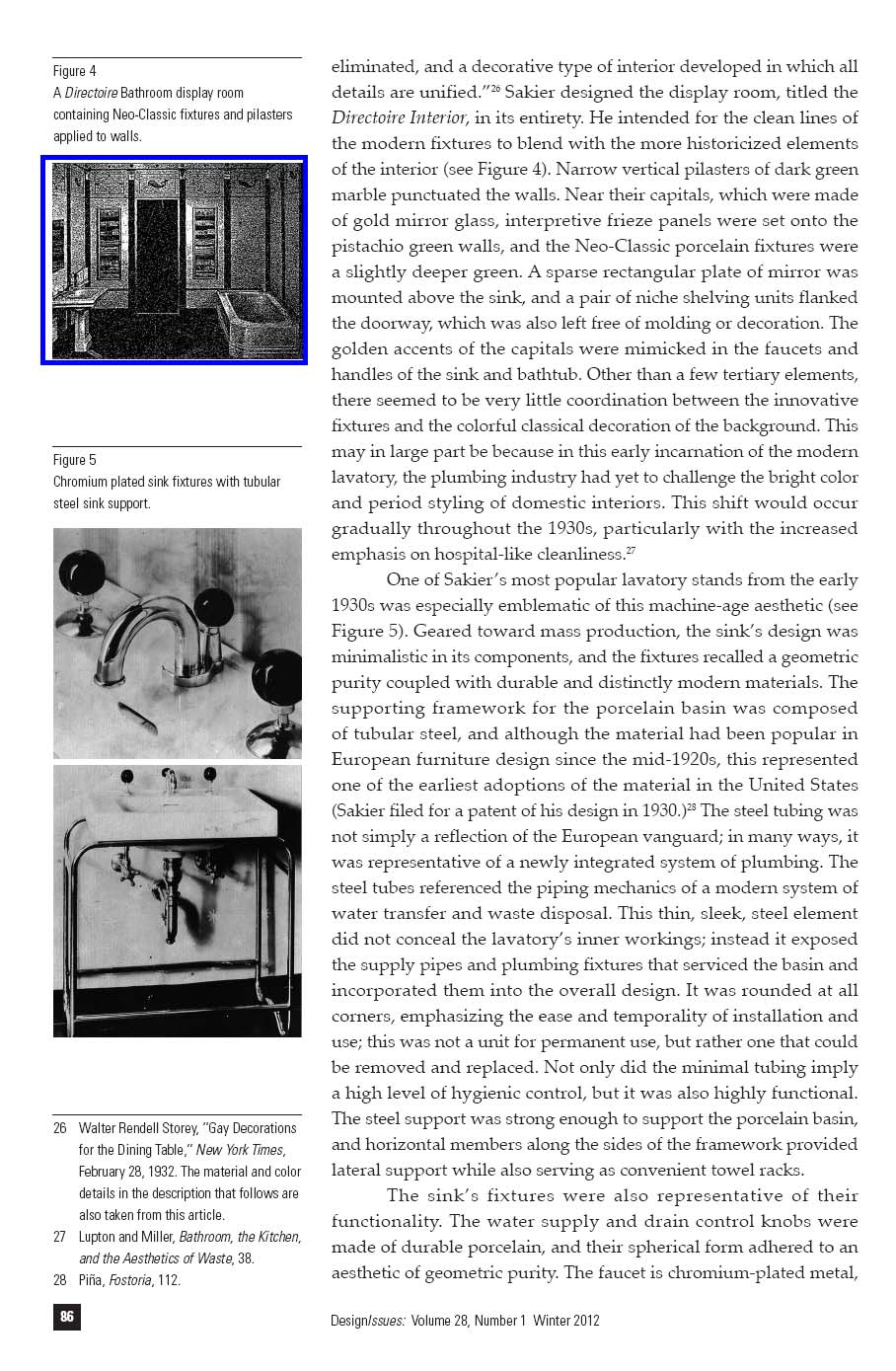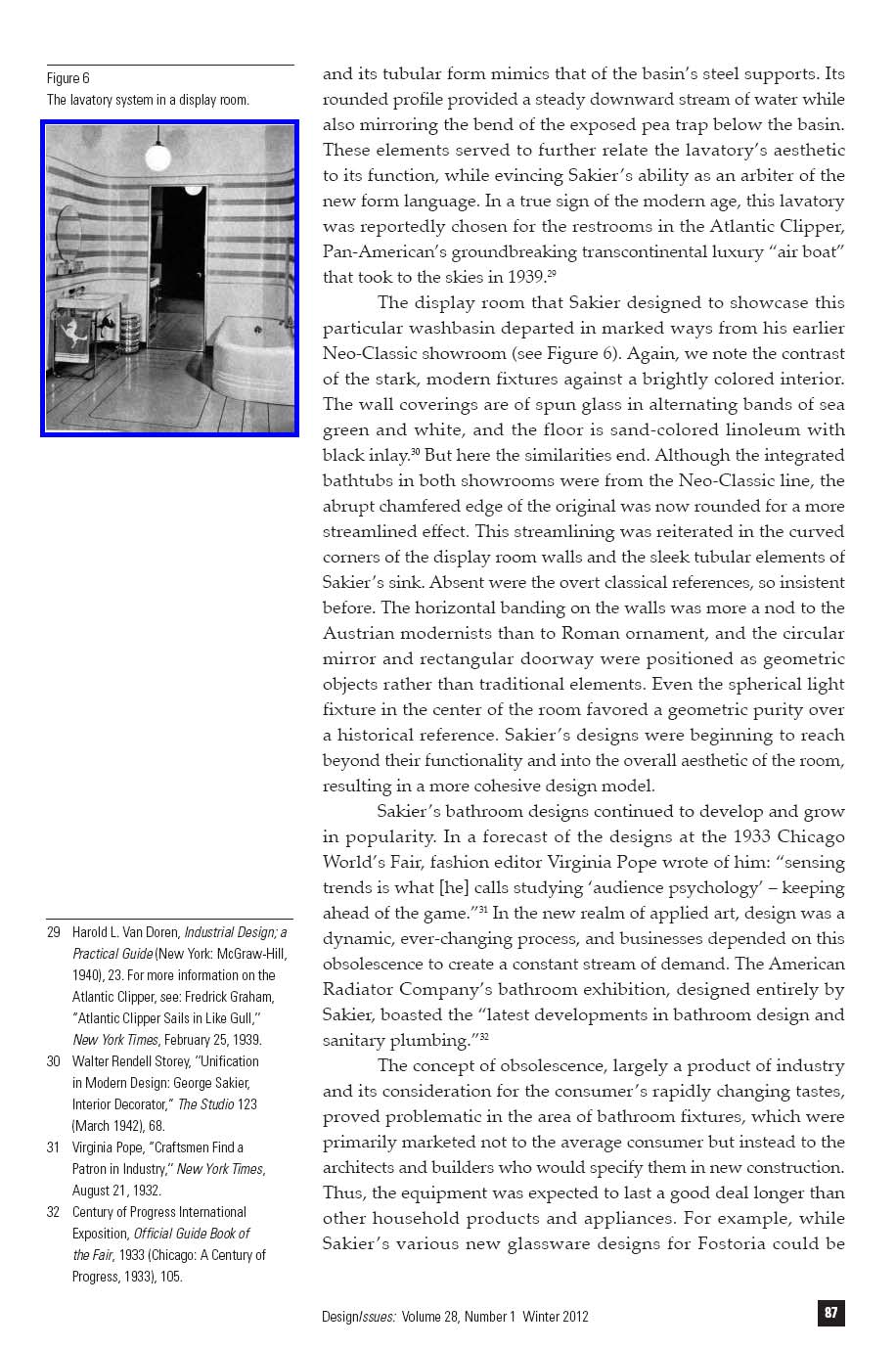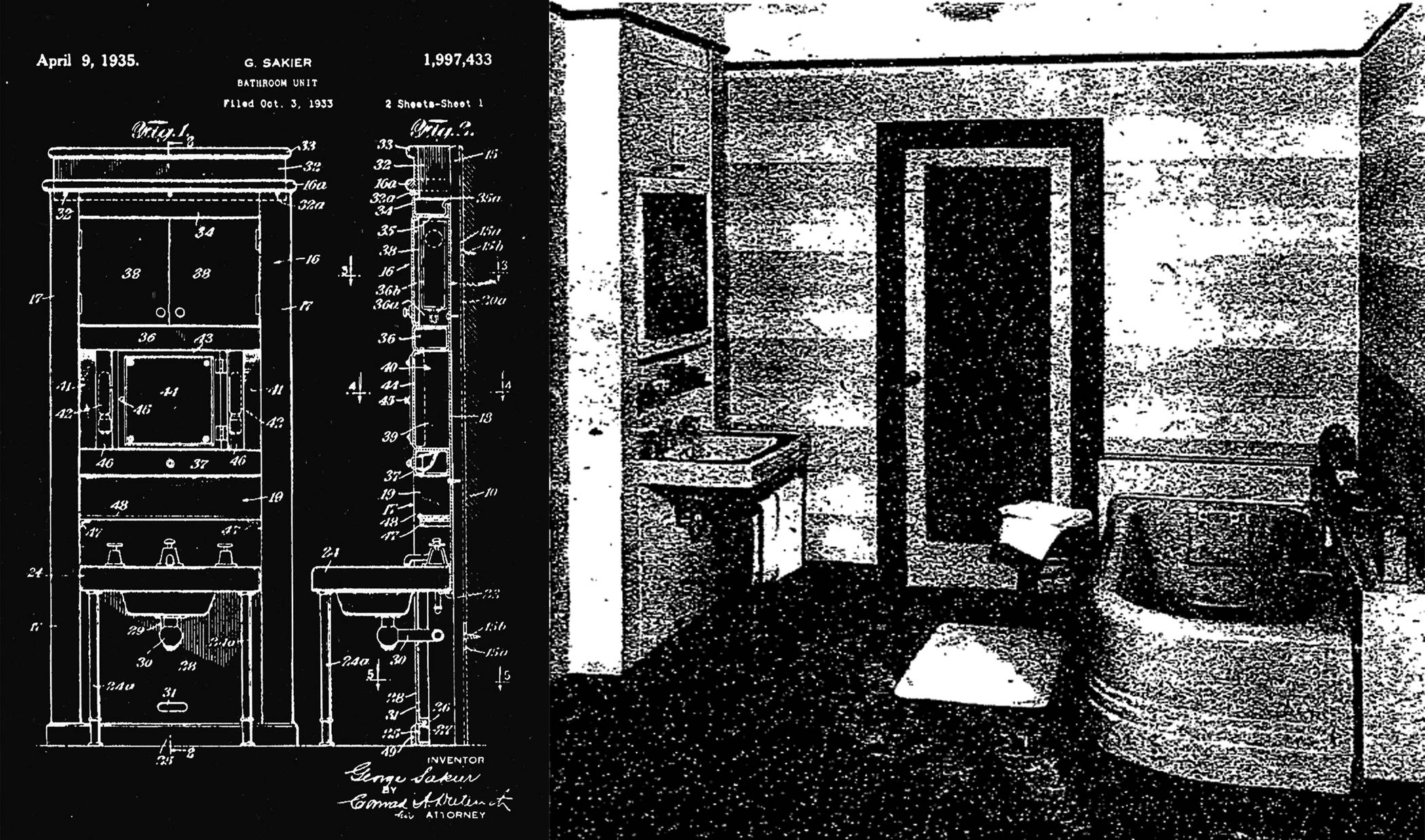The Quiet Dissemination of
American Modernism: George
Sakier’s Designs
for American Radiator
Christine Taylor Klein
George Sakier was a versatile practitioner who worked as an interior
designer, painter, art director, engineer, and packaging designer. He
was also one of the original industrial designers in America. His
career path was as diverse as it was extensive, and his impact upon
the development of a modern design aesthetic pervaded not only in
the United States but also in Europe.
To understand Sakier’s ability to produce designs that have
become so pervasive in the American household, one must look to
his earlier career—a period of time that Fortune magazine called
his “trek from camouflage to bathtubs.”1 During this era, partic-
ularly in the 1930s, Sakier emerged as an arbiter of modernism and
as one of the first industrial designers. His bathroom and kitchen
fixture designs for the American Radiator Company reveal some of
the earliest embodiments of a uniquely American modernist style.
Through the market appeal and affordability of his industrially
designed products, Sakier quietly disseminated his modern aesthetic
throughout the country.
1 George Nelson, “Both Fish and Fowl,”
Fortune (February 1934), 40.
2 Sakier’s descendents believe that the
From Camouflage to Bathtubs
original family name may have been
Sakier’s father, Samuel, immigrated to Palestine as a member of
“Sirkin” and that Samuel, like many
the Bilu’im—a group of Zionists who fled Russia during the 1880s
Jewish immigrants of his time, may
to avoid the anti-Semitic “May Laws” of Tsar Alexander III.2 The
have changed his name when he
Bilu’im were trailblazing idealists that established an agrarian
moved to the United States.
3 For more on the BILU Movement,
cooperative society.3 Life in Palestine was fraught with disease and
see: Samuel Kurland and Hechalutz
drought, and by the turn of the century, Samuel left the farming
Organization of America, Biluim, Pioneers
experiment to settle in New York City, where he married and worked
of Zionist Colonization (New York: Pub.
as a paper and twine merchant.4 George was born the second of
for Hechalutz organization of America by
three children in December 1897. Although the family could not
Scopus publishing company, 1943).
4 “Samuel Sakier,” New York Times,
have been considered wealthy, each of the three children was given
January 4, 1934. This obituary claims
a high level of education. While both his siblings remained closely
that Samuel “settled in New York about
involved with their Jewish heritage (his older Brother Abraham
1900,” but given that George was born
was an ardent supporter of the Zionist movement and his younger
in 1897 and that George’s older brother
sister Helen was an active board member of a prominent Jewish
Abraham was also born in New York,
social agency), George took a dif erent path. His early exposure to
it is likely that Samuel arrived in the
US as early as 1894.
© 2011 Massachusetts Institute of Technology
81
DesignIssues: Volume 28, Number 1 Winter 2012
influence the design discourse abroad. A decade later, when his
glassware designs for Fostoria first began receiving wide acclaim, he
would again influence the European modern aesthetic when “he
won the distinction of having his own designs for glass pirated
in Europe.”10
Sakier returned to New York around 1926. While in Europe,
he had gained experience as an assistant art director for French
Vogue, and he worked as art director for Modes and Manners and
Harper’s Bazaar until the end of the decade.11 By then, he had
also secured jobs as head designer at the American Radiator and
Sanitary Corporation and as a consultant designer for Fostoria
Glass Company. His service with both companies would last for
decades, and his work led him to wide acclaim in the new realm of
industrial design.
Fostoria, under whose employ Sakier made his most lauded
and recognizable work, was founded in 1887 in Fostoria, OH. The
location for the original factory was chosen “to take advantage of the
free natural gas offered [there] as an inducement to industrial users
with the money to set up a factory.”12 The company later moved to
West Virginia; Sakier would send his designs here for elaboration by
an in-house design team, and the products would be manufactured
and marketed to middle-class households all over the country.
Sakier was hired as part of Fostoria’s aggressive design overhaul—
an attempt to keep pace with the competition by modernizing its
wares.13 Under his direction, the company began to offer a broad
range of tableware, most of which evinced a combination of
neoclassical and modernist sensibilities. Fostoria prospered from
Sakier’s “simpler, friendlier” modernism, and its success inspired
other glassware companies to embrace the trend in the 1930s.14
As dynamic and innovative as Sakier’s designs were, they
often retained classical elements. Because he was designing for
the American middle-class consumer, even his more avant-garde
glass pieces tended to merely imply modernism rather than to fully
embody it. His geometric forms for footed stemware were often
accented with classical floral etching; candelabras with geometric
accents retained column-like fluting; and goblet stems were topped
10 Ibid.
with detailing similar to Roman capitals.
11 Piña,
Fostoria, 8.
12 Charles Lane Venable et al., China and
American Radiator and the Culture of the Bathroom
Glass in America, 1880-1980: From
Sakier’s full expression of modern, utilitarian purity and social
Tabletop to TV Tray (Dallas Museum
awareness is most evident and compelling in his work with the
of Art, 2000), 174.
American Radiator and Standard Sanitary Corporation. At first
13 Ibid.
14 “Notes on Glass Design,” Advertising
glance, plumbing may seem an unlikely catalyst for the prolif-
Arts (January 1933), 21. Quoted in
eration of modern design in America. However, plumbing and its
Kristina Wilson, Livable modernism:
accompanying fixtures are, in fact, rife with modernist implications.
interior decorating and design during the
Other parts of the house did not lend themselves as readily to such
Great Depression (Yale University Press
modern advances. “Designers and manufacturers,” Kristina Wilson
in association with the Yale University
Art Gallery, 2004).
has written, “found it more difficult to argue that a modernist sofa,
DesignIssues: Volume 28, Number 1 Winter 2012
83


Figure 3
panels that Sakier designed for the company would ultimately
Patent drawings of the Neo-Classic line for
become his most modern and arguably most influential contri-
the Waldorf Astoria Hotel (lavatory basin
butions to industrial design.
pedestal, top; bathtub, bottom)
In his first years at American Radiator, his designs stayed
close to the typical neoclassical forms that drew great interest from
upper class consumers (see Figure 2). Critic Sheldon Cheney wrote
of his early works, “Sakier was creating exhibition ensembles as
luxurious as any of those advertised, for their ‘rich and Oriental
splendor,’ for their Greco-Roman ‘period’ authenticity, or for their
Spanish exoticism.”21 One bathroom design in particular, which
included oversized tubs and gold taps, was priced at an opulent
$7,000. Despite this application of ornament, Cheney, an ardent
modernist, conceded that Sakier’s design prowess shone through:
“[Sakier’s] work was always distinguished by a delicately perceptive
discrimination and a genuine originality in new material use.”22
All of this opulence would, of course, fall away in the
aftermath of the economic collapse of 1929, after which Sakier
would turn his attention toward a simpler and more astringent
aesthetic. Shortly after the market crash, construction began on the
new Waldorf-Astoria hotel in New York City. The architecture firm,
Schultz and Weaver, designed the remarkable building, then the
largest hotel in the world, with more than 2,000 guest rooms and 300
residential suites.23 Theo Arens, president of American Radiator and
Sakier’s boss, was determined to win the contract for the bathroom
installations, and he set Sakier to work designing an entirely new
line of fixtures for the hotel. The result was Sakier’s Neo-Classic line,
a misleading title given its strong lines and geometric shapes (see
Figure 3). In fact, he meant for the name to be interpreted literally; he
intended for the fixtures to become the “new classic” for bathrooms.
The design established an aesthetic based upon the utilitarian
function of the plumbing and machinery with which it operated.24
Schultz was pleased with the designs, and American Radiator won
out over Kohler, the hotel company’s previous supplier. The success
bolstered Sakier’s notoriety, propelling his designs into numerous
journals and magazines that praised the work as an embodiment
of the emerging machine aesthetic. Architect Raymond Hood,
21 Sheldon Cheney and Martha Smathers
who designed the American Radiator’s own high-rise building a
Candler Cheney, Art and the machine:
few years earlier, remarked that the fixtures had “an architectural
an account of industrial design in
character that blends them into the design of the room. They have
20th-century America (Acanthus Press,
the basic quality of good design,” he added, “of being straight-
1992), 78.
forward and simple.”25
22 Ibid.
The Neo-Classic bathroom concept was exhibited in one of
23 Joseph J. Korom, The American
Skyscraper, 1850-1940: A Celebration of
the display rooms at The American Radiator and Standard Sanitary
Height (Branden Books, 2008), 423.
Corporation, and, in it, Sakier combined the modernized fixtures
24 Piña,
Fostoria, 109.
with elements of pared-down classicism to achieve maximum appeal
25 Raymond Hood quote originally posted
to consumers. Walter Rendel Storey, art critic for the New York Times,
in “What Others Say,” a promotional
described the fixtures as moving toward a “smart simplicity,” where
brochure for the Neo-Classical line.
Quoted in: Ibid., 113.
the “old-time fussiness of the ornamented bathroom has been
DesignIssues: Volume 28, Number 1 Winter 2012
85




Figure 7
continuously added to production with little risk of outdating the
Top: patent drawing for the lavatory segment
previous lines, the tolerance for such rapid change, and subsequent
of the Arco Unit Panel System.
obsolescence, in the bathroom was considerably lower. Because of
Bottom: bathtub and lavatory units (shown in
the permanence of the fixtures and the organization of the laborers,
sheet metal)
the bathroom and plumbing industry was generally slower to
respond to new technologies. Aside from its inherent reluctance to
innovation, the plumbing fixture industry was also facing a growing
number of charges of an even greater economic and social nature.
George Nelson, in a 1934 piece for Fortune on the new vocation of
industrial design, cited this social neglect as leading to the “basic
indictment of the reactionary building industry which, in an
industrial capitalistic country, is technologically unable to build
houses cheap enough to house two-thirds of the people above a
minimal standard of decency.”33 An article in Architectural Record
pointed out that, despite the relative achievements of American
plumbing, a 1934 study of 64 typical cities revealed that “5% of all
dwellings had no running water, 13.5% had no private indoor water
closets, 20.2% had neither bathtubs nor showers.”34
Sakier answered this social charge with his design for the first
prefabricated bathroom, the Arco Unit Panel System, released in 1933
for the Accessories Company, a division of American Radiator (see
Figure 7).35 Cheney called it Sakier’s “machine for cleanliness”—the
bathroom’s response to Le Corbusier’s visualization of the home
as a “machine à habiter.”36 The system consisted of three separate
components—a washbasin, bathtub, and toilet—each containing
all the necessary fixtures and accessories in an adjustable metal
wall section for easy installation in new construction or joined to
existing plumbing for renovation work. The three main components,
along with additional paneling for the flooring and wal s, could be
interlocked to create a single unified system, or each part could be
used separately, depending on need and budget. The lavatory unit,
by far the most complex and inclusive, contained a porcelain bowl
with tubular metal legs and chromium-finished faucet components.
The sink element was attached to a wall panel six to eight inches
deep—deep enough to conceal the plumbing pipes and to avoid
disturbing the building wall. The panel included shelving and a
33 Nelson, “Both Fish and Fowl,” 97.
34 “Technical News and Research: A
mirrored medicine closet, bordered by lighting that conveniently
Prefabricated Bathroom” Architectural
plugged into the nearest wall socket. The panel was made of two
Record, (January 1937), 39.
vertically telescoping pieces to accommodate rooms of various
35 Note that Architectural Record in
heights, and the sink legs easily adjusted to account for uneven
1936 and 1937 consistently refered to
floors.37 The toilet component held the tank within the wall unit
these panels as “Arcode Sectionals.”
to remain accessible for quick repairs and, once again, to avoid any
Elsewhere, the systems are referred
to as Arco.
pipe installation within the building’s walls. An available option in
36 Cheney,
Art and the machine, 79.
this unit was a convector radiator, capable of heating an 8’ x 10’
37 Walter Rendell Storey, “Ease and Style
room, particularly in the area of the toilet.38 And, of course, the
in Outdoor Furniture,” New York Times,
colors and finishes of each component were customizable to suit the
June 18, 1933.
consumer’s taste. The system was a revolutionary contribution to the
38 “Technical News and Research: A
Prefabricated Bathroom,” 46.
88
DesignIssues: Volume 28, Number 1 Winter 2012
development of prefabrication and industrial design in America. Its
high functionality and technical beauty earned the Arco Panel Unit
System a position in the influential Machine Art exhibition at New
York’s Museum of Modern Art (MoMA) in 1934.39
The entire system was designed to optimize comfort in use
and convenience in installation, while also imparting a modernist
look. More importantly, it was intended to be readily affordable
and widely applicable. The same year as the MoMA exhibit, it was
reported that 133 of the units were being installed in an apartment
building in Washington, DC, and 400 more were slated for instal-
lation in another building.40 Within a few years, the Arco Units were
installed in thousands of homes and apartments.41 The immediate
interest in the concept seemed to validate Sakier’s social initiative
and design ideal. However, the project never reached the level of
commercial success that his other lines with American Radiator
enjoyed. Like so many other attempts to market prefabricated
components in the 1930s and 1940s, including several later ef orts
by Buckminster Fuller, the unit was never adopted as a prototype.
Perhaps consumer interest waned when presented with such a
rigidly modernist system; perhaps the consumer could not reconcile
the notion of adaptable bathroom components with preconceptions
of the architectural fixedness of previous components. Most likely
to blame were the plumbers and contractors who failed to evolve
in response to the new technology. American architect Alexander
Kira reflected on the stubbornness within the “structuring of the
plumbing industry, which has followed the pattern peculiar to the
home-building industry: field erection and assembly of thousands
of independently produced and often unrelated items.”42
Despite these problems, Sakier continued to investigate
prefabrication as a mode of production and installation with the
introduction of the “packaged kitchen” assembly for the Accessories
Company in 1936. The kitchen panels were intended to complement
those of the bathroom system and implemented many of the same
design ideals. Steel wall sections, each of which were capable of
sustaining a bearing load of 7,000 pounds, were assembled and
framed into the house, and the cabinets and equipment were
mounted on this system.43 The system was modular, offering 15, 20,
39 For more information on the exhibit,
and 35-inch segments to allow for flexibility in arrangement and to
see Machine Art: March 6 to April 30,
accommodate different types of layouts. For a large kitchen with a
1934, Museum of Modern Art, New
pantry, the retail price was around $500, but the smaller, straight-line
York (New York: Museum of Modern
assemblies could run as low as $275. The units were broken down
Art, 1969).
40 Nelson, “Both Fish and Fowl,” 98.
into different construction types to allow for the various levels of
41 Cheney,
Art and the machine, 79.
budgeting. Different assemblies were offered for houses in several
42 Alexander Kira, The Bathroom (Viking
different price ranges: $15,000 and above, $8,000 to $15,000, and
Press, 1976), 9.
less than $8,000. Sakier designed the kitchen system to be highly
43 This description is paraphrased from
functional, while also promoting modern hygiene and efficiency.
“Technical News and Research:
Integrated Kitchens,” Architectural
Record (October 1936).
DesignIssues: Volume 28, Number 1 Winter 2012
89
In 1936, he wrote an article for House and Garden intended to
appeal to female consumers, who were the primary market for such
fixtures. He equated the chore of cooking with a type of artistry and
invited his female readers to “imagine a breadboard that lets down
at the touch of a finger,” or “a ‘kitchen dashboard’ with sockets and
switches for electric appliances.”44 There was a designated area for a
paper towel roll right next to the sink faucets, “where, of course, it
should be.”45 If his prefabricated bathroom panels were “machines
for cleanliness,” then his kitchen systems were machines for cooking,
cleaning, storing, and household management. Sakier was able to
successfully combine modern modes of design and assembly with
the traditional methods of household engineering promoted a
decade earlier by Christine Frederick, who argued that each aspect
of the kitchen should be composed to minimize labor and maximize
comfort and ease of use.46
A Modest Legacy of Modernism
With each of these designs, Sakier sought to inject the new ideals
of modernism into the accessories of domestic life. As an artist, his
work for American Radiator seemed an odd fit—even to him—
although ultimately he found it a satisfying situation: “At dinner,”
he once wrote, “when my partner feels it is about time to ask what
I do, I general y, albeit I have more romantic wares to of er, answer
that I design bathtubs. The response is electric, earnest, and most
gratifying. I am now sure of her complete attention for at least three
courses… I become a social asset.”47 Although painting remained
his passion, Sakier relished the notion that his designs had spread
so broadly across the country, imparting his ideals of functionality
and efficiency into innumerable homes.
Acknowledgements
This article is the result of Professor Christopher Long’s seminar
course on Modern American Design at the University of Texas at
Austin. I owe a debt of thanks to Professor Long for his guidance
and encouragement. Thanks also to Susan Blumberg, Sakier’s
grandniece, Martha González Palacios, head librarian of the
Architecture and Planning Library at the University of Texas at
Austin, and Christian Klein, professional designer and intellectual
buttress.
44 George Sakier, “Her Kitchen,”House
and Garden 70 (October 1936), 142.
45 Ibid.
46 Christine Frederick, Household
Engineering: Scientific Management
in the Home (American School of
Home Economics, 1920).
47 George Sakier, “Hot and Cold,”
photocopy of undated article in
George Sakier Foundation archives.
Quoted in Piña, Fostoria.
90
DesignIssues: Volume 28, Number 1 Winter 2012





